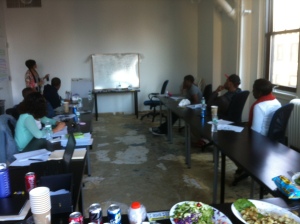Longtime readers of this blog might remember that I am mildly fascinated with time perspective as it relates to young people setting goals and making decisions. I recently finished Philip Zimbardo and John Boyd’s book, The Time Paradox, which is chock full of facts and insights, both interesting and provocative. The Stanford psychology professors share a lifetime’s worth of research and reflection on time and human behavior, and part of the richness of their work owes to the fact that they don’t hesitate to draw from childhood memories, personal anecdotes, and song lyrics, even as they ground all their theories in science.
From a youth development standpoint, there are important lessons to be gleaned. Here are the three I found most vital to my work:
1. Many of the systems in this world are “built by futures for futures.”
Any sort of program or institution that tries to scare people straight with an idea of dire future consequences—from D.A.R.E. to the criminal justice system—falls into this category. The problem is, not everyone lives with a future time perspective. Many behavioral programs only work for individuals whose distant future is tangible to them. Adolescents are generally extremely present-oriented, and if they live stressful lives, they are that much more attuned to the present and unaware of their future potential.
2. The good news is that time perspective is malleable. We can all work toward a balanced time perspective—an optimum combination of past positive, present hedonistic, and future orientation—for our well-being.
Armed with knowledge and intention, we can alter our time perspective. Zimbardo and Boyd have had success helping students set and meet goals by leading them through visualization exercises. They add that to reinforce a future time perspective, we also need to teach young people concepts and skills such as contingencies, causalities, delaying gratification, planning, and self-reward. Project work is a great way for youth to practice these lessons in context.
For people with the opposite problem of being too future-oriented, the authors recommend we practice mindfulness and integrate into our lives more present-oriented activities such as, yes, stopping to smell the roses and taking unimportant stuff off our to-do lists.
3. Diminishing a past-negative time perspective is vital to our ability to lead happy, productive lives.
I definitely sat up when I read the section of The Time Paradox on how to diminish a past-negative time perspective by revisiting childhood memories and trying to see them from another viewpoint. The authors cite an example of a woman who grows up feeling rejected by her father because he would rebuff her affection whenever he got home from work. They suggest that she could make herself understand that her father was probably too tired to play with her, and that his way of showing his love for her was by tucking her into bed after he’d gotten the chance to unwind.
Would that everyone’s family issues were so simple. But I am reminded of a post I wrote on Louise Erdrich’s short story, “The Shawl” (curiously enough, one of the most popular hits on this blog), where the narrator comes to terms with a family history of trauma and violence with a transformative interpretation of a painful family incident.

